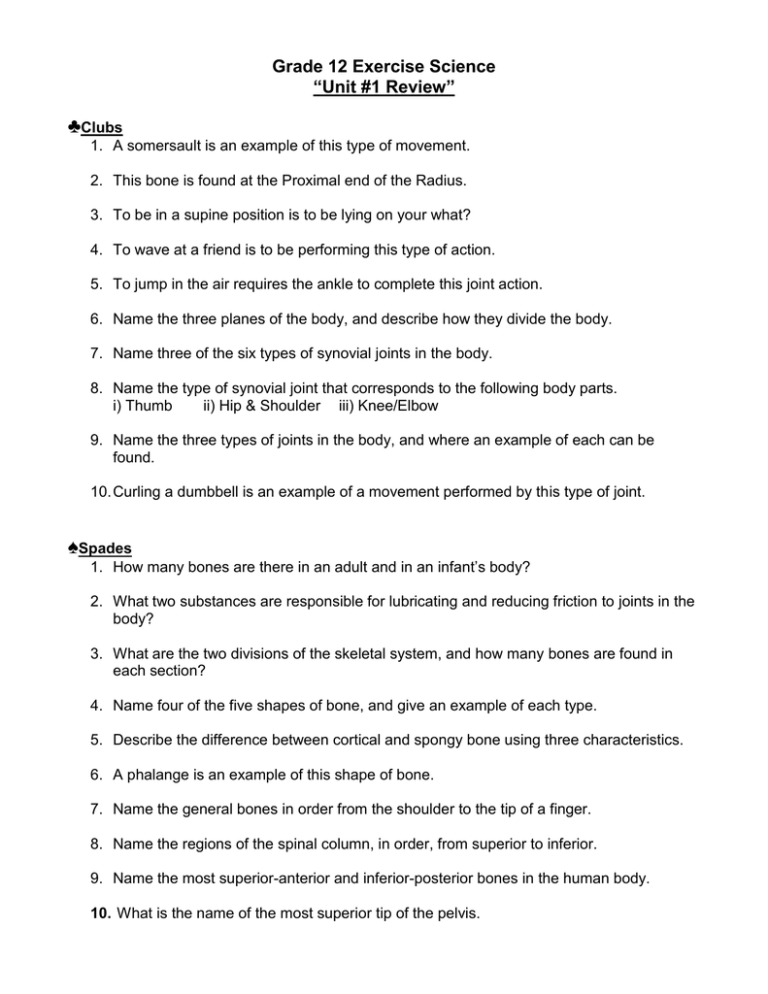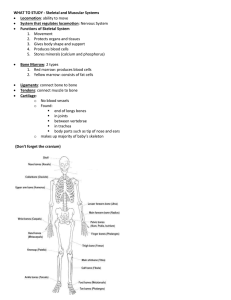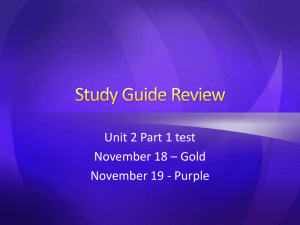Unit #1 Test Review Package
advertisement

Grade 12 Exercise Science “Unit #1 Review” ♣Clubs 1. A somersault is an example of this type of movement. 2. This bone is found at the Proximal end of the Radius. 3. To be in a supine position is to be lying on your what? 4. To wave at a friend is to be performing this type of action. 5. To jump in the air requires the ankle to complete this joint action. 6. Name the three planes of the body, and describe how they divide the body. 7. Name three of the six types of synovial joints in the body. 8. Name the type of synovial joint that corresponds to the following body parts. i) Thumb ii) Hip & Shoulder iii) Knee/Elbow 9. Name the three types of joints in the body, and where an example of each can be found. 10. Curling a dumbbell is an example of a movement performed by this type of joint. ♠Spades 1. How many bones are there in an adult and in an infant’s body? 2. What two substances are responsible for lubricating and reducing friction to joints in the body? 3. What are the two divisions of the skeletal system, and how many bones are found in each section? 4. Name four of the five shapes of bone, and give an example of each type. 5. Describe the difference between cortical and spongy bone using three characteristics. 6. A phalange is an example of this shape of bone. 7. Name the general bones in order from the shoulder to the tip of a finger. 8. Name the regions of the spinal column, in order, from superior to inferior. 9. Name the most superior-anterior and inferior-posterior bones in the human body. 10. What is the name of the most superior tip of the pelvis. ♥Hearts 1. Name five of the seven types of bone fractures. 2. This type of fracture occurs when muscle and/or tendon break a piece of bone away from the main bone body. 3. Of all the types of fractures, this is the most difficult to repair. 4. This is the main muscle that you are sitting on right now. 5. This is the general muscle group that causes flexion of the knee. 6. What is the name of the smallest unit of the muscle, and what two components work together within it to create contraction and flexion? 7. What three ligaments are involved in the injury known as the “Unholy Trinity”? 8. What is the difference between a tendon and a ligament? 9. What is the P.I.E.R theory in dealing with athletic injuries? 10. What muscle is responsible for dorsiflexion of the ankle? ♦Diamonds 1. Describe the difference between concentric and eccentric contractions. 2. Name the two main muscles involved in the flexion of the elbow of a push-up, and describe the type of contraction each is performing. 3. What is the primary source of energy for all three types of energy systems, and what are the by-products of its chemical reaction? 4. Name the three energy systems by naming the system used for each the following activities. i) 12-minute run ii) Bench Press iii) 200 metre sprint 5. Which energy system is limited by the health/conditioning of the lungs? 6. What part of the heart is responsible for pumping oxygenated blood to the rest of the body? 7. What arteries supply blood to the heart muscle? 8. What are the smallest units of the vascular system that diffuse oxygen to the muscles. 9. What term describes the amount of blood pumped from the heart in one beat? 10. What does VO2 measure? Grade 12 Exercise Science “Unit Review Tournament” Answers ♣Clubs 1. Frontal or Coronal Plane movement. 2. Humerus 3. Back 4. Abduction 5. Plantar Flexion 6. i) Sagital/Medial (Medial/Lateral) ii) Frontal/Sagital (anterior/posterior) iii) Horizontal/Transverse (Superior/Inferior) 7. –Saddle -Pivot -Ball & Socket -Ellipsoidal -Hinge -Plane 8. i) Thumb: Saddle ii) Hip/Shoulder: Ball & Socket: iii) Knee/Elbow: Hinge 9. i) Fibrous: Skull ii) Cartilaginous: Spine/ribs iii) Synovial: Any 10. Hinge ♠Spades 1. Adult: 206 Infant: 350 2. Cartilage, synovial fluid 3. Axial: 80 Appendicular: 126 4. Long, Short, Flat, Sesamoid, Irregular 5. Describe the difference between cortical and spongy bone using three characteristics. 6. Long 7. Humerus, ulna, radius, carpals, metacarpals, phalanges 8. Atlas, Axis, Cervical, Thoracic, Lumbar, Sacrum, Coccyx 9. S-A: Frontal Bone, I-P: Calcaneous 10. Illium Crest ♥Hearts 1. i) Greenstick iv) Comminuted vii) Compression ii) Simple/Transverse v) Pathological iii) Compound vi) Avulsion 2. Avulsion 3. Comminuted 4. Gluteus Maximus 5. Hamstrings 6. Sarcomere: Actin Filament, Myosin Filament 7. ACL, PCL, LCL 8. Ligamants attach bone to bone, Tendons attach muscle to bone 9. i) Pressure ii) Ice iii) Elevation iv) Rest 10. Tibialis Anterior ♦Diamonds 1. Concentric: Muscle shortens when the muscle is contracted Eccentric: Muscle lengthens when the muscle is contracted 2. Tricep: Concentric Bicep: Eccentric 3. ATP ADP + Energy + P 4. i) 12-minute run: Aerobic/oxidative iii) 200 metre sprint: Anaerobic Lactic ii) Bench Press: ATP/Anaerobic Alactic 5. Aerobic 6. Left Ventricle 7. Coronary Arteries 8. Capillaries 9. Stroke Volume 10. Amount of 02 used by the body in a given respiration.








